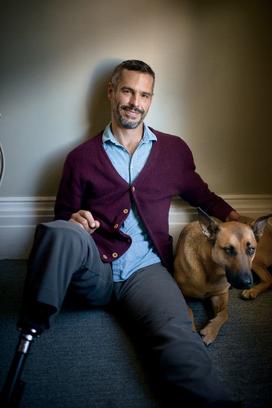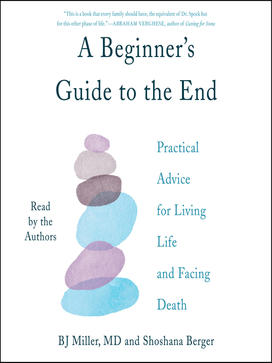BJ Miller ’93’s Advice for End-of-Life Planning

The book: Preparing for death can seem overwhelming. How do you tell your boss? Who should you designate to make health decisions when you can’t? What about those family secrets? What exactly are hospice care and palliative care? In this guide, BJ Miller ’93 and Shoshana Berger suggest that individuals can thoughtfully and deliberately put their affairs in order and answer these questions by following a series of practical steps.
A Beginner’s Guide to the End: Practical Advice for Living Life and Facing Death (Simon & Schuster) offers practical, compassionate advice for individuals facing death, as well as for their loved ones who must buy a casket, write a eulogy, and shut down accounts. “There is nothing wrong with you for dying,” Berger and Miller write in their introduction. “Our ultimate purpose here… is to free up as much life as possible until you do.”
The authors: BJ Miller ’93 is a hospice and palliative medicine physician who has worked in many settings — inpatient, outpatient, hospice facility, and home — and now sees patients and families at the UCSF Helen Diller Family Comprehensive Cancer Center. Miller speaks all over the country and beyond on the theme of living well in the face of death..
Shoshana Berger is the global editorial director at IDEO, where she has worked on projects ranging from the end of life to modern Judaism to school lunch. She was a senior editor at WIRED, and has written for the New York Times, WIRED, Popular Science, Marie Claire, and Salon. She co-founded the DIY design magazine ReadyMade, later turning it into a book, ReadyMade: How to Make (Almost) Everything.

Opening lines: BJ’s Story
Part of the reason I wound up becoming a doctor is that I came close to death in my own life, earlier than expected and in a dramatic enough way that I had little choice but to sit up and take notice.
One night when I was a sophomore in college, a couple of friends and I headed out for an hour or two on the town and then made our way to the Wawa for hoagies. On the way, we crossed the old rail line. There sat the Dinky, a two-car commuter train that ran from Princeton to Princeton Junction, with a ladder up the back. We were exuberant kids spotting a perfectly climbable tree.
I jumped on first, and when I stood up the electric current arced to my metal wristwatch, blowing 11,000 volts up my arm and down and out my feet.
For the lark, I lost half of an arm and both legs below the knee. I was taken to St. Barnabas Hospital in Livingston, New Jersey’s one burn unit. I was intubated but awake, and could hear the trauma team taking bets on my survival, some saying “This guy’s a goner”; others betting “We got this.” The nurse, Joi, who would become a guiding light for me, must have seen my eyes widening, so she told them to shut up and came to my side. She showed me I was safe there, even amidst danger. Together with close friends, family, and the staff of the burn unit, I would begin to learn what it felt like to be cared for. The terror and grace of depending on others for life.
That place would be home for the next four months. One night, it began to snow outside. I remember the nurses chatting about the drive in. There was no window in my room, but it was all lovely and frustrating to imagine. The next day, my friend Pete smuggled in a snowball for me. Drip by drip, that little shrinking thing unpacked a rapture. Snow, time, water. Now, knowing that creation held room for both ends, it mattered less whether I lived or died. For a moment death was in its place: obvious, common, benign.
So began my formal relationship with death.
I returned to college in the fall. I was trying to be a normal college student, but things were not normal yet. I’d ditched the wheelchair for a used golf cart, but I had a giant right arm from pushing myself around for months. The rest of me was rail thin. I wore a brown prescription compression vest over my scar tissue so it wouldn’t ball up. My skin was sallow. I had a hook at the end of my arm stump that I rarely used and just hung there instead. Really, I was pretty disgusting, always drenched in sweat, squishing around in my legs that had their own odor, leaving puddles wherever I sat. I’d go into the dorm showers on my knees, sitting down amid the hair balls and athlete’s foot flakes, so I was never sure if showering actually made me cleaner. But that didn’t matter; water running over my skin didn’t hurt anymore. It felt downright glorious.
My leg prostheses were sheathed in flesh-colored nylons and fitted into style-free orthopedic shoes that took me about twenty minutes per shoe to lace up with one hand and a hook, so I never took them off and they soon molded when the rains came. When you start out on prostheses, you’re constantly building up your tolerance, walking just a few steps more at a time, turning your skin from thin to callused. Making the unnatural natural. Learning and changing, as a newborn does.
I had a service dog named Vermont who saved me again and again. Five minutes playing fetch with him pulled me out of just about every psychological spiral I might spin down. Watching him run and leap never failed to yank me past bitterness: it might as well have been me running around the field. I watched him always be present, never burning time wondering why his life wasn’t different than it was. I aspired to be more like him. Plus, he needed me, and I loved him with every cell I had left, which was plenty.
Tantrums came and went less and less often. I shrunk my needs and got much more specific about couldn’ts versus wouldn’ts. Could I really not get onto an escalator now, or did I need not worry so much about leaning into someone? Could I really not go shopping, or was I too proud to use my wheelchair? Could I really not dance, or was I afraid of embarrassing myself? The practice was tedious, but it got me up and out.
Looking different had its useful bits, too. Had my injury been less obvious, I might have kept trying to pass. But the conspicuousness of it was, eventually, freeing. As a kid, I had been very neat and particular about my appearance. Now I wore shredded clothes and let my hair grow out. I wore shorts every chance I got—for a time, comically short ones; it was as though I needed some skin to touch the air. I needed people to see that I wasn’t afraid, so that I wouldn’t be. I learned not to constantly compare my new body to my old body or to other people’s. Instead, I could engage in the creative process of making my way through the day.
I got close enough to see something of death and come back from the ledge, only to realize that it’s in and around us all the time. And now I see this truth in my patients, looking to change and be themselves all at once.
Reviews: “A Beginner’s Guide to the End is honest, funny, luminous, and essential. Full of real-world advice and hard-won insight, it’s a practical guide to dying that is actually much more about living.” – Lucy Kalanithi, author of the epilogue to When Breath Becomes Air by her husband, Paul Kalanithi











1 Response
Norman Ravitch *62
6 Years AgoRead a Book?
Better than reading a book would be to engage an estate-planning attorney. Such an attorney won't bite you! Nor will his bill likely be excessive for the peace of mind he can offer you over time. A book won't do that. (I am not an attorney or an employee of a law firm! Or someone who thinks lawyers are always necessary or desirable -- except in this case.)